Most professionals interested in the use of technology in education understand the importance of an e-learning course site, whether the course is taught totally online or in a hybrid environment where the instructor has some face-to-face contact with students. On a typical course site, an instructor posts announcements, a course syllabus, class notes and presentations, and related learning materials for easy access by students. In addition, some instructors use the course site to facilitate forums and chats, to receive and return student assignments, to administer online quizzes and tests, and to maintain an online gradebook. However, how many instructors have thoroughly considered the importance of posting policy documents on a course Web site? Our experience as teachers and e-learning mentors reveals that this important component of a course site is frequently underdeveloped or even missing entirely. Moreover, we have not found references to the subject of course policies in the e-learning literature.
In any learning environment, students should have a clear understanding of what the instructor expects from them, as well as what they can expect from the instructor. This need is more urgent for e-learning students than for traditional students because e-learning activities—typically technology-based and self-directed—often occur in an environment where students may have difficulty getting timely answers to important questions. Thus, instructors should anticipate their students’ needs for clarity by posting detailed policy documents in a prominent section of the course site. These policies will help instructors as well as students, since they make managing an e-learning course much easier.
In what follows, the informal "you" specifically addresses e-learning instructors who will devise and use course policy statements. By implication, we are speaking also to the technology professionals and librarians who support and interact with e-learning instructors and who can help acquaint them with the ideas we advance. We discuss nine categories of course policies that instructors might consider posting:
- E-learning Policies in the Course Syllabus
- Student Privacy Policies
- E-Mail Policies
- Discussion Policies
- Software Standards Policies
- Assignment Policies
- Getting Technical Help Policies
- Student Code of Conduct Policies
- Intellectual Property Rights Policies
E-learning Policies in the Course Syllabus
Virtually every academic course has a course syllabus that lists the course goals, sets a course schedule, identifies course texts and other required materials, and explains how to contact the instructor outside of scheduled class activities. Typically a course syllabus also sets forth general criteria used to administer the course, such as an attendance policy, and a grading policy that explains how student performance will be evaluated.
In an e-learning course, you should post the course syllabus on the course site and include several additional policy statements. First, because e-learning involves electronic communication, advise students to visit the course site once a day to view new announcements and require them to read e-mail daily to peruse course information disseminated via this medium. Second, inform students that whenever they submit course assignments by e-mail or on CD or disk, they are responsible for assuring that computer files holding these assignments are virus-free; files that fail your institution’s virus checker software will not be opened or accepted. Finally, your course syllabus should contain a statement to the effect that ignorance of course policies set forth in the syllabus or posted elsewhere on the course site is not an excuse for failure to conform to these policies. Of course, the existence of the course policies and how to access them should be prominently publicized in whatever introduction you provide for students who enter the course.
Student Privacy Policies
Privacy policies and related procedures protect a student’s legal right to privacy and confidentiality. Most educational institutions in the United States have a student privacy policy consonant with the Family Educational Rights and Privacy Act (FERPA).1 If your institution’s policy is available online, post a link to it on your course site; otherwise, post a copy of the policy itself. Of course, you should also post your own student privacy policy if it is distinct from that of the institution.
To protect student privacy, you can restrict access to your course site so that outsiders cannot see the resources that reside there, including students’ discussion responses, for example. Bear in mind that students’ privacy rights are violated when they are required to post photographs and other personal information on a course site, as in getting-to-know-each-other activities. Such activities should be voluntary, not required, and your privacy policy should make this very clear. Also, references to personal traits such as race, ethnicity, disabilities, age, and gender should be made public only if a student initiates the actions to do so.
Student privacy concerns are as much a matter of perception as they are of substance. Although there are exceptions, most students will not object to your making information about them available to other students and to course site visitors. However, most students will appreciate knowing that approving access by others to such material is entirely voluntary. In particular, if you plan to publicize students’ work inside or outside of the course site—including, for example, their words in electronic discussions, e-mail, or assignments—be sure to inform them of your intent and obtain their permission to do so. Figure 1 provides an example form you might use to obtain such permissions.
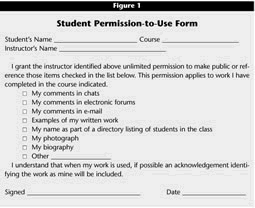
Figure 1,Click image for larger view.
E-Mail Policies
E-learning instructors routinely report being overwhelmed by the need to answer numerous e-mails they receive from students, especially in totally online courses having no face-to-face interaction with students. If you allow e-mail to monopolize your time, it will be very difficult to manage your other course responsibilities. Posting an e-mail policy that limits your e-mail workload is therefore a good idea. Consider the following three approaches to minimizing the workload e-mail imposes on you. Figure 2, based on these approaches, provides an example e-mail policy statement.
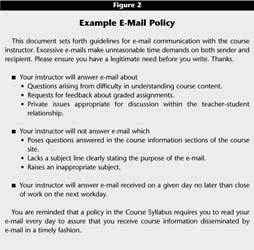
Figure 2, Click image for larger view.
Define Appropriate E-Mail Topics
Provide clear policies stating the type of e-mail you will respond to. For example, you might establish a policy whereby you will respond only to e-mail that deals with students’ personal concerns, their difficulties comprehending course content, or their need for clarification about graded work. Require students to refer to the course site for general course information and course policies instead of requesting it from you by e-mail. Besides reducing your e-mail load, this practice also encourages students to be self-sufficient in finding answers to their questions.
Provide detailed information about the course in the syllabus, in assignment instructions, in announcements, in the course calendar, in the policies section of your course site, and in other course material. Then establish as part of your e-mail policy that you will not respond to e-mail about test dates, how students’ grades will be determined, or any other information that is clearly posted as general course information on the course site.
Set a Reasonable Response Time
It is important to establish an e-mail response time so that students will know when they can expect to hear from you. A clearly stated response time helps constrain frustration when students don’t hear back from you in what they consider to be a timely fashion. It also reduces the number of repeat e-mails with messages such as "I haven’t heard from you, so I’m resending this e-mail." You might choose to respond to appropriate e-mail from your students within 24 hours of the time they write, on a 7-days-a-week basis, or within some other set period of time except on weekends and holidays. An alternative approach is to associate e-mail response times with office hours. For example, you might respond to e-mail on Mondays from 10:00 a.m. to 12:00 p.m. EST, Wednesdays from 2:00 to 4:00 p.m. EST, and Fridays from 12:00 to 1:00 p.m. EST. If you use this approach, it is particularly important to include time zones, since you may be dealing with geographically dispersed students.
Use Alternatives to E-Mail
You can post announcements on the course site as an alternative to responding to several e-mails on the same topic. For this approach to work, you must require students to visit the course site at least once a day to read new announcements.
Electronic discussions constitute another alternative to e-mail by providing opportunities for students to answer each other’s questions. An ongoing forum for students allows them to post and respond to questions about tests, deadlines, or any other related course information. It is likely that a few students will emerge as mentors for other students. Most classes contain one or more individuals who, given such an opportunity, will act as unappointed helpers of others in the class. Alternately, you might solicit the help of such mentors by offering grade credit for the service. In addition, you—or your course assistant, if you have one—can visit the discussion periodically to determine whether or not further clarification is needed and post a response directly in the discussion or via a course announcement. This approach encourages students to work with each other and to be self-sufficient yet allows you to provide them appropriate feedback as necessary.
Yet another alternative to e-mail is to establish electronic office hours via a chat. For example, you could arrange to be available to students in a chat on Mondays, Wednesdays, and Fridays from 12:00 to 2:00 p.m. EST.
Discussion Policies
We use the term discussion to denote both chats and forums. A discussion policy contains guidelines governing your students’ participation in chats and forums, including the degree to which you yourself will enter into student discussions. For example, some instructors participate in a discussion only after all students have had a chance to respond. If you use this approach, state this explicitly, so students will not be expecting more frequent participation from you.
If student participation in electronic discussions is required, this should also be clearly stated in your discussion policy. Furthermore, if you are planning to grade students on their participation in discussions, you should clearly indicate what grading criteria apply in posted instructions for that particular discussion. For example, will grades be based on the quality as well as the number of responses? Will students be expected to respond to other students’ postings? What is the deadline for postings? Figure 3 provides an example discussion policy.
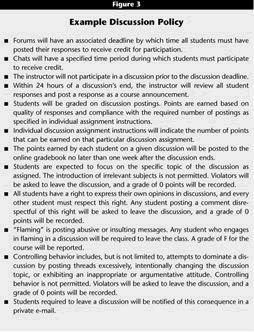
Figure 3,Click image for larger view.
Software Standards Policies
To access a document you place on the course site, students must have software that recognizes the file format of the document. If the document is in HTML format—most files posted on the Internet are—any Web browser can open it. However, you may wish to post documents that use other file formats, for example documents created using word processor or presentation graphics software. To open such a document, students typically—but not always—must have the same software program you used to create it. Likewise, when a student sends you an electronic assignment document, for example, to open and read the file you will probably need the same software the student used to make the document. Of course, many software programs for e-learning are proprietary and hence not available without cost. As a consequence, it will probably be necessary for you—and/or your institution—to establish standards that delimit the software required to participate in your e-learning course.
Our institution—Embry-Riddle Aeronautical University—has adopted Microsoft Office as its e-learning software standard. Office software resides on every computer on our two residential campuses and at more than 130 learning centers located around the world. Our license also allows our students to load Office software onto their personal computers without charge. Thus instructors and students can freely interchange information in MS Word and PowerPoint formats, as well as in other file formats supported by Office.
It has been estimated that 90 percent of all personal computers in the world have Microsoft Office software installed on them. Thus Office file formats have become de facto standards, allowing information to be shared among computer users worldwide. Moreover, both PC-based and Apple personal computers can run Office software. However, our point here is not that you should adopt Office for your e-learning course. We merely suggest that software standards are virtually a requirement for successful e-learning, and the course policy section of your course site should clearly articulate what standards you have established.
Assignment Policies
Clear guidelines governing written assignments are very important, in part because they reduce student frustration when preparing assignments and also because they can reduce the amount of e-mail students will send you asking for clarification. Three important considerations in devising an assignment policy and related procedures are discussed below. Figure 4 provides an example assignment policy.
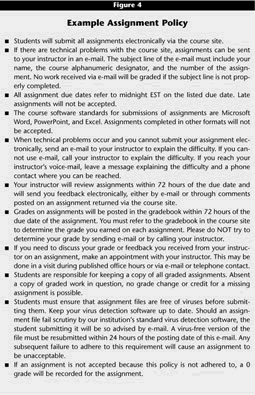
Figure 4,Click image for larger view.
Establish Submission Guidelines
Establish guidelines about how students should submit completed assignments. If an assignment is sent by e-mail, establish a procedure requiring that students place their full names, course identification, and a brief assignment identifier both in the subject line of the e-mail and in a prominent heading on any attachments. Alternatively, you might ask students to place assignments in a course site storage area where you have read and write privileges and students have only write privileges. Also, emphasize that you will accept files only if they are virus free and in a format that conforms to your software standards policy.
In an e-learning environment, it is inevitable that technical difficulties will occur from time to time. Such problems include trouble with a home computer or an Internet connection and downtime on the course site server, among others. Your assignment policy must clearly state what students should do when they experience such difficulties while attempting to submit an assignment. One alternative is to have students fax in their assignments, following the fax with an electronic submission when the existing computer problem is cleared up. Another approach would require that students call you by a designated time to explain their difficulties and negotiate a plan for submitting their assignments. However, the latter approach may be viable only when an e-learning class is small.
Inevitably, a few students will abuse your assignment policy by claiming technical difficulties when they do not exist. You probably need to include in your assignment policy a statement that students must have regular access to a computer and a reliable Internet connection to enroll in your course. If a student repeatedly claims technical difficulties when submitting late assignments, you will then have justification for reflecting in your grading the failure to meet course requirements.
Establish Feedback Guidelines
To reduce the number of e-mails and calls you receive from students with questions about graded work, establish guidelines on the types of feedback students can expect. For example, you might want to respond to work submitted electronically by recording your feedback directly on the work and returning it electronically. Most word processing programs facilitate typing easily distinguishable feedback directly on files submitted by students. If you have a tablet PC, you can handwrite on an electronic assignment. Also, establish parameters as to when students can expect to receive graded work back, such as within five days after submitting the assignment for totally online courses, by the next or second next class period for hybrid courses, or within some other appropriate time frame.
You should also establish procedures for how students can discuss graded work with you personally. For example, if the course meets in person, you can specify that you will discuss the work during your office hours, but only during a limited time period, for example within five days of a student’s receipt of the graded work. If your course is delivered totally online, you might make yourself available to discuss graded work—within the same time period—by phone, by e-mail, or in a chat session.
Keep Permanent Records of Assignments
It is a good idea to require students to keep a copy of all graded work, just in case a technology failure destroys an online grade book and grades have to be recreated.2
Getting Technical Help Policies
We have all experienced the frustrations of having technical difficulties with computers that we could not resolve without assistance. For e-learning students, this kind of frustration is often compounded, especially when they are working under the pressure of assignment deadlines. As a consequence, it is imperative that you have a policy explaining how a student can receive help for technical difficulties.
Your institution might well have published guidelines about how students can receive help on technical issues with course sites, as well as with computers in laboratories. If so, post these guidelines—or a link to them if they reside online—in the technical help policy document on your course site. In addition, your technical help policy should specify what kinds of problems students should not expect to get help with. Computers that students use off campus are typically their own responsibility, and this should be clearly established in the technical help policy.
Some institutions are establishing technical help desks. An example is Rio Salado College, which serves adult learners. Such students often cite a lack of timely support as a reason for abandoning their studies. The Rio Salado help desk, staffed by non-instructional personnel, assists students in resolving technical problems. In addition, the college has established an innovative Beep-a-Tutor program available 24 hours a day, 7 days a week. Students who leave a telephone request for help will receive a response within one hour. The tutors who supply responses are alerted by means of beepers, making it unnecessary for them to stay close to a telephone or a computer in case a request for help arrives.3
If your institution has not established a technology help desk, consider establishing a personal help desk for your course. It can be managed by student assistants or teaching assistants who are available at designated times to talk with students by phone, by e-mail, or in chat sessions. Another alternative for courses where students meet face to face is to use student leaders with advanced technical skills to help less technical students. You would then specify how a student requiring help can make contact with a student leader. You, or your assistants, would stay in close touch with student leaders to coordinate technology issues and find solutions for difficulties that the student leaders cannot resolve. Student leaders can be compensated with extra credit on their grades, as appropriate, or paid a modest salary if funds are available.
Your technical help policy should also specify how you will contact your students in case technical problems arise that cannot be solved expeditiously. Besides your students’ e-mail addresses, you probably should know their work and/or home phone telephone numbers and their fax numbers. You may gather this data and related information—preferably at the outset of the course—by having students complete a survey form posted on the course site.
Finally, your technical help policy should specify what you plan to do if technical difficulties arise when an online test is scheduled. Figure 5 provides an example policy on getting technical help.
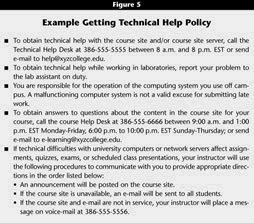
Figure 5,Click image for larger view.
Student Code of Conduct Policies
It is prudent to establish a student code of conduct policy explaining how you expect students to conduct themselves in the e-learning environment. Consider making the code of conduct a signed contract between you and your students. Figure 6 provides an example Student Conduct Contract. We discuss four categories of student conduct guidelines:
- Behavior in Electronic Communications
- Attendance
- Self-Motivation and Self-Direction
- Cheating and Plagiarism
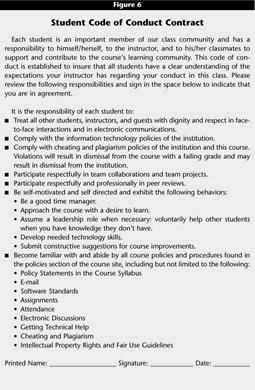
Figure 6,Click image for larger view.
Behavior in Electronic Communications
Encourage students to be courteous and professional in e-mail communications and electronic discussions. The code of conduct in electronic discussion should include guidelines governing unacceptable behaviors, such as disrespectful responses to other students or the instructor, complaints about the course, or the use of inappropriate language. Provide students with examples of appropriate behavior and responses as well as inappropriate ones. If you plan to allow students the freedom to initiate forums or chats without consulting with you beforehand, you should include a policy on the types of subjects that are appropriate and those that are inappropriate.
Attendance
A code of conduct policy should address attendance requirements. At the same time, taking attendance in an e-learning environment, especially in a totally online course, is more problematic than in a traditional learning environment. Participation in required e-learning activities can be construed as attendance in an e-learning course. Absence—failure to reply to e-mail or engage in a discussion or chat, for example—is lack of participation.
One of the most effective techniques to promote participation in e-learning activities is to ensure that participation counts towards a student’s grades. If you choose to use this form of motivation, your code of conduct policy should so indicate, and both your assignment policy and your course syllabus should specify how attendance will be figured into the final course grade.
Self-Motivation and Self-Direction
A code of conduct policy should state your expectations of students with respect to self-motivation and self-direction in an e-learning environment. Adult learners, who are typically more mature and more experienced than younger students, often have a better understanding than younger students of what is required in a self-directed environment. Young students, and students new to e-learning, may need considerable help to achieve the same appreciation for self-reliance that most mature learners have. Consider including the following recommendations in your student code of conduct policy:
- Be self-motivated and self-disciplined.
- Be a good time manager.
- Approach the course with a desire to learn.
- Assume a leadership role, and be a teacher when necessary. Voluntarily help other students, bearing in mind, however, that doing other people’s work for them is tantamount to cheating.
- Develop needed technology skills.
- Contribute to course discussions. Listen to others, and respond respectfully to their comments.
- Contribute to team activities, and respect the ideas of others.
- Comply with all course policies.
- Submit constructive suggestions for improving the course.
Cheating and Plagiarism
A code of conduct policy should address cheating and plagiarism. Post institutional policies on cheating and plagiarism and associated penalties as part of your online student code of conduct policy.
In an e-learning environment, there exist ample opportunities for students to collaborate with each other when taking online tests:
- Getting someone else to take a test
- Group test taking where students gather together in a lab or at a student’s domicile
- Printing and distributing copies of online tests
One way to deal with this situation is to view online tests as learning experiences and to allow student collaboration and the free use of notes and other sources of information. On the other hand, if you prohibit some or all of these behaviors, your code of conduct policy should clearly state the rules for taking online tests and the penalties associated with violating these rules. In reality, it is difficult or impossible to prevent student collaboration during unproctored online testing.
Plagiarism is a problem becoming more widespread through an increase in Web sites where students can buy reports and papers. The 2003 National Survey of Student Engagement found that 87 percent of students surveyed "indicated that their peers at least ‘sometimes’ copied and pasted information from the Internet for reports/papers without citing the source."4 Students must be made aware that this practice is flagrantly dishonest and that engaging in it will result in dismissal from the course and perhaps from the institution. Also, some students naively believe that anything posted on the Web may be freely incorporated in their work without the need to identify and credit the source. Your intellectual property policy, discussed next, should explain to students that using the ideas of others improperly also constitutes dishonesty.
Intellectual Property Rights Policy
The Internet makes it very easy to obtain and use work created by others, hence easy to violate their rights to this work. An intellectual property rights policy helps students understand and avoid the improper use of the intellectual property of others. Below we briefly discuss copyright law, fair use guidelines, and the Digital Millennium Copyright Act (DMCA) and the Technology, Education, and Copyright Harmonization (TEACH) Act—subjects not infrequently misunderstood by students and sometimes by e-learning instructors. The information we present has been abstracted from the e-learning literature and related sources.5 Bear in mind that what follows was written by laymen and that we have not consulted lawyers to verify the validity of the ideas we present.
Copyright Law
Copyright is the legal exclusive right of someone who creates a work—for example a poem, a song, a photograph, an article, a book, or a video—to control the copying of all or a portion of that work. By providing a basis for lawsuits to compensate for financial or emotional loss resulting when someone uses another’s work unfairly, copyright law attempts to assure that we can profit fairly from our efforts. Someone who creates a work possesses what is sometimes called intellectual property rights to that artifact. No specific action is required to obtain these rights, nor must a copyright notice be attached to the work for it to be protected. Copyright is implied by the existence of the work as soon as the work is placed in a medium that can be distributed or copied, even when the medium is simply an unpublished manuscript.6
Copyrights are not eternal. When an artifact becomes old enough to be out of copyright, others may use it as they wish. Such material is said to be in the public domain. For example, editions of Mark Twain’s novels published in the nineteenth and early twentieth centuries are long out of copyright, hence in the public domain. You and your students are free to quote from any of these old editions or even to copy such a book in its entirety to a Web site. Except under the fair use guidelines explained below, however, you could not post pages scanned from a contemporary reprint of one of Twain’s novels. This remains true even though the copyrighted reprint was itself produced from an edition of the novel in the public domain.
Many Web authors, but certainly not all, consider their Web sites to be in the public domain and are willing to share freely the information these sites contain. To be on the safe side, however, one should assume that material created by others—electronic or otherwise—is not available free of charge. This includes everything obtained from the Web—text, images, audio, or video—as well as anything you use or scan from a picture, book, magazine, or other source. This doesn’t mean that you and your students can’t use materials from the Web and other sources to create e-learning assignments and resources; it simply means that when you use such materials, you must follow the guidelines explained below.
Fair Use Guidelines
Fair use is a legal principle that defines the limitations on the exclusive rights of copyright holders. Unfortunately, there is no simple test to determine fair use.7 Fair Use Guidelines established by Congress attempt to clarify the extent to which educators and students—among others—can legally use copyrighted information without first obtaining the permission of the copyright holder. The guidelines fall into four categories, as follow.8
The Purpose and Character of Use. Nonprofit educational use is favored over commercial use, although the latter is not automatically disqualifying. Uses that transform the original work creatively weigh in favor of fair use. Examples are parody and sequels.
The Nature of the Copyrighted Work. Fair use is more likely if the work you copy is fact based—for example, history or biography—rather than imaginative, such as a novel. Fair use is more likely if the source is published as opposed to unpublished.
Amount of and Significance of the Portion of Work Cited. The amount of information fair use allows is based on the length of the work from which you take the information. The longer the original work, the more information you may appropriate from it, up to a certain maximum limit. One source advocates a ten-percent rule for online materials.9 This rule specifies that you may use the smaller of
- One-thousand words or ten percent of a prose work
- Thirty seconds of music or ten percent of length of the complete composition
- Three minutes or ten percent of a video
- Two-hundred fifty words or ten percent of a poem
Effect on the Potential Market or Value of the Work. Citations that significantly diminish the market for the original are unlikely to constitute fair use. For example, if you take large amounts of information from a textbook, and if as a consequence your students do not have to buy a book they might otherwise be required to purchase, your use might decrease the author’s royalties.
Copyright and fair use are complicated legal issues. If your institution has promulgated specific guidelines for posting copyrighted material on the Web, make these guidelines a part of your intellectual property policy. Then assure that you and your students obey them to the letter. Always err on the side of caution. If you or your students become subject to litigation because of a copyright violation, your institution will almost surely have more financial liability than you do because its pockets are much deeper.
Figure 7 is a checklist—taken with permission from the Copyright Management Center at Indiana University–Purdue University-Indianapolis—to help you and your students determine if information you contemplate using in an e-learning course meets fair use guidelines.10 To obtain further information on fair use, take the University of Texas System’s Crash Course in Copyright.11
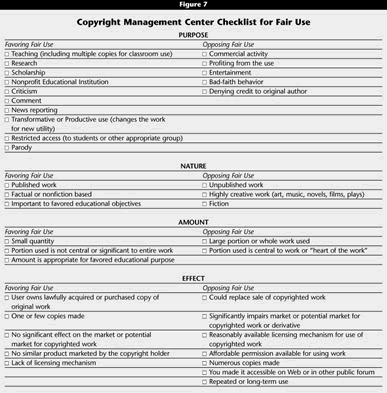
Figure 7,Click image for larger view.
The DMCA and the TEACH Act
In addition to fair use guidelines, two pieces of U.S. federal legislation are relevant to intellectual property rights. One is the DMCA, enacted in 1998; the other is the TEACH Act, signed into law in 2002. These acts—too broad to address in detail here—are briefly described below. To determine your institution’s guidelines for compliance with DCMA and the TEACH Act, consult the legal department or a knowledgeable reference librarian.
DCMA12 is a comprehensive reform of U. S. copyright law focusing on the digital age. The act was designed in part to implement a copyright protection treaty signed in 1996 by member countries of the World Intellectual Property Organization, an agency of the United Nations.13 DMCA specifies the terms according to which instructors, librarians, students, and staff may use e-mail, Web sites, and other technology at their institutions, although the legislation is not specific to educational applications. One major aspect of this act for instructors is that if your course site allows students to download text, graphics, or other Web content, you could be liable for any copyright infringement if you have not taken the precautions prescribed in the DMCA.
The TEACH Act updates U.S. copyright law as it relates to online courses.14 It was specifically motivated by the development of distance education e-learning courses that use the Internet to distribute information. The act specifies conditions under which an accredited, nonprofit educational institution in the United States may digitally transmit—without permission or license fees—a copyrighted work (or a portion thereof) to a legitimate student audience. Compliance with the act is likely—but of course not ensured, since compliance is a legal issue—when instructors and/or institutions:
- Limit access to the copyrighted works to students currently enrolled in the class.
- Limit access to only the time needed to complete the class session or course.
- Inform instructors, students, and staff of copyright laws and policies.
- Prevent further copying or redistribution of copyrighted works.
- Do not interfere with copy protection mechanisms.15
Most learning management software makes it easy to comply with the first and second of these five criteria, and you can pursue compliance with the remaining three by appropriate statements in your Intellectual Property Rights Policy.
For additional information on the TEACH Act, consult the TEACH Toolkit Web site (maintained by North Carolina State University),16 the American Library Association report on distance education and the TEACH Act,17 and a detailed article by Kenneth Crews at the Copyright Management Center explaining how to comply with the TEACH Act.18
Students and Intellectual Property Issues
When students unfairly use materials created by others in e-learning assignments, they are guilty of plagiarism. This applies to any and all sources they use, including the materials on your course site. Your intellectual property policy probably should contain a statement that your course resources—together with the announcements you post and your words in electronic discussions—belong to you and/or your university, not to students who might wish to use them. Advise your students that they must understand and abide by laws and guidelines protecting intellectual property.
The same caveat holds true for discussion entries and other electronic artifacts that students produce while taking your course. Your statement should make clear that course materials are for class purposes only and cannot be distributed to others without violating the intellectual property rights and/or the privacy rights of the owners of these materials, whether the course instructor, students in the course, or those who created outside sources of information.
Concluding Remarks
A number of the policies discussed here might best be formulated at the institutional level rather than at the level of individual courses. Notable among these are a student privacy policy, a discussion policy, a software standards policy, and an intellectual property rights policy. Such institution-wide standards will likely evolve in the future, as implied by efforts of the Association for College and University Policy Administrators to develop a policy development process applicable to information technology departments.19 Currently, however, you will probably have to devise and publish your own policies without significant assistance from others in the information technology and educational technology communities. Doing so will cost you a significant amount of time and effort. Nevertheless, formulating e-learning policies is a task well worth undertaking. Students are more likely to achieve the learning goals you help them set when they know precisely what rules govern the pursuit of these goals. Moreover, the use of e-learning policies will save you time in the long run by simplifying course administration. They provide readily available answers to the numerous procedural questions that inevitably arise as students progress through your course, questions that—absent your e-learning policy statements—you would have to answer individually many times over.
Well-formulated e-learning policies might be compared to the Federal Aviation Regulations an airplane pilot follows when making a cross-country flight. Both the planning and execution of the flight are governed by these rules promoting safety and the orderly flow of air traffic. These rules are available online or in printed format and are abstracted in the many books and documents used in pilot training. Similarly, the policies section of your course site is a repository of rules for the efficient and "safe" conduct of your e-learning course. Take time to formulate the rules clearly and thoroughly. You and your students will ultimately use them to the benefit of everyone concerned.
